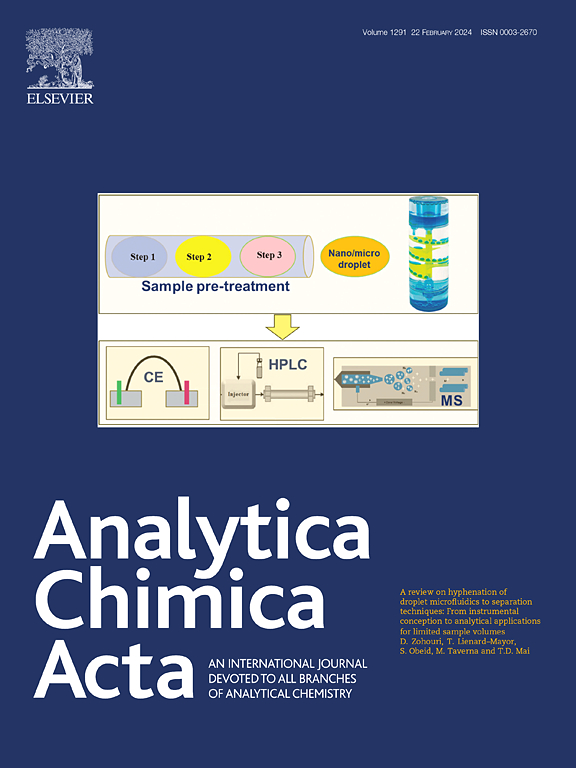自体荧光法检测尿样样品中a - β1-42 -淀粉样肽不同聚集阶段的高灵敏度
IF 6
2区 化学
Q1 CHEMISTRY, ANALYTICAL
引用次数: 0
摘要
一些研究表明,包括a - β1-42在内的β-淀粉样肽的纤颤过程在不同阶段可能具有毒性。这一过程与神经退行性疾病(如阿尔茨海默病或帕金森病)患者大脑中斑块的形成有关。因此,检测体液样本中β-淀粉样蛋白聚集的不同阶段,对评估最终神经退行性病理的分期,从而在疾病的最初阶段实现某种诊断提出了重大挑战。如今,质谱或分析离心等技术可用于研究淀粉样蛋白聚集,但它们仍然昂贵且耗时,因此不适合常规临床实践。在这里,我们展示了一种新型传感器的开发,该传感器设计用于检测模拟人类尿液的体液中a β1-42的低丰度聚集体。该传感器采用了一种创新技术,利用由热释电效应产生的电场的积累效率,将微小体积的样品集中在反应载玻片上。该浓度允许检测聚集体的自动荧光信号。这种方法,我们称之为“热电流体动力射流”或p-射流,利用铁电材料的固有电场,而不需要外部电极,从而产生更紧凑和流线型的电流体动力提取微小液滴。淀粉样蛋白及其聚集阶段的无标记、快速和敏感的分类是可以实现的。该方法对尿样样品中β-淀粉样蛋白聚集体具有皮克级的灵敏度,明显优于普通的光谱技术。本文章由计算机程序翻译,如有差异,请以英文原文为准。


Highly sensitive detection of different aggregation stages of Aβ1-42 -amyloid peptide in urine-like samples by auto-fluorescence
Several studies demonstrated that the fibrillation process of β-amyloid peptides, including Aβ1-42, can be toxic at different stages. Such process is involved in the formation of plaques in the brains of patients affected by neurodegenerative diseases, such as Alzheimer's or Parkinson's disease. Therefore, detecting different stages of β-amyloid aggregation in a sample of body fluid poses a significant challenge to evaluate the stadiation of an eventual neurodegenerative pathology and hence to achieve a certain diagnosis in the very first stages of the disease. Nowadays, techniques like mass spectroscopy or analytical centrifugation are available for studying amyloid aggregations, but they remain expensive and time-consuming and hence, not suitable for routine clinical practice. Here, we show the development of a novel sensor designed to detect low abundant aggregates of Aβ1-42 in a body fluid that mimics human urine. This sensor utilizes an innovative technique that exploits the accumulation efficiency of an electric field generated by the pyroelectric effect to concentrate tiny volumes of sample onto a reaction slide. This concentration allows for the detection of the auto-fluorescent signal of the aggregates. This method, which we refer to as a ‘pyro-electrohydrodynamic jet ' or p-jet, uses the intrinsic electric field of a ferroelectric material without external electrodes, resulting in a more compact and streamlined electro-hydrodynamic extraction of tiny droplets. A label-free, rapid, and sensitive classification of amyloids and their aggregation stages is achievable. Demonstrating picogram-level sensitivity for β-amyloid aggregates in urine-like samples, this method significantly outperforms common spectroscopic techniques.
求助全文
通过发布文献求助,成功后即可免费获取论文全文。
去求助
来源期刊

Analytica Chimica Acta
化学-分析化学
CiteScore
10.40
自引率
6.50%
发文量
1081
审稿时长
38 days
期刊介绍:
Analytica Chimica Acta has an open access mirror journal Analytica Chimica Acta: X, sharing the same aims and scope, editorial team, submission system and rigorous peer review.
Analytica Chimica Acta provides a forum for the rapid publication of original research, and critical, comprehensive reviews dealing with all aspects of fundamental and applied modern analytical chemistry. The journal welcomes the submission of research papers which report studies concerning the development of new and significant analytical methodologies. In determining the suitability of submitted articles for publication, particular scrutiny will be placed on the degree of novelty and impact of the research and the extent to which it adds to the existing body of knowledge in analytical chemistry.
 求助内容:
求助内容: 应助结果提醒方式:
应助结果提醒方式:


